Intown neighborhoods support Beltline rail. Let me say that again, Intown neighborhoods support Beltline rail! I’m president of the Inman Park Neighborhood Association and we’ve supported mass transit and Beltline rail from the beginning.
And by beginning, I mean 1889.
Inman Park is the city’s first suburb with a planned streetcar. Eighteenth-century businessman Joel Hurt established the first electric streetcar along Edgewood Avenue (also America’s first profitable electric trolley line). Inman Park exists because of light rail. The Trolley Barn stands as a proud reminder of our streetcar legacy. What better way to get back to our roots than with a streetcar returning to Inman Park.
Credit: contributed
Credit: contributed
The Streetcar East Extension was identified as the first light rail project on the Beltline for several reasons: It connects to the existing streetcar downtown and has relatively few engineering challenges or barriers to completion. And funding is available, thanks to multiple sources, including the 71 percent of voters who overwhelmingly supported the More MARTA sales tax referendum in 2016.
When neighbors say the streetcar will ruin the neighborhood, I say instead the streetcar is the reason for our neighborhood. The streetcar was ever-present in Inman Park until the routes became obsolete as automakers created vehicles for the mass market. Unfortunately, this transition to individual modes of transportation valued exclusion over equitable mass transit. The streetcars vanished completely in 1949.
Exclusion still rears its ugly head, trying to keep the Beltline Streetcar out of Intown neighborhoods. A new group called “Better Atlanta Transit” wants to build anything but better transit. They want to keep the Beltline only for pedestrians and cyclists. They don’t seem to understand that the Beltline serves all people, including those who commute to their jobs, can’t afford or don’t want a car yet need access to work and amenities along the Beltline, those with disabilities and those who use the Beltline during extreme hot or cold weather. A Beltline streetcar also will offer a safe way for students attending K-12 schools and universities along the trail to get to school.
Opponents claim that increasing “micro mobility” (aka more scooters) is the answer to Atlanta’s mass transit needs. But that doesn’t help people with disabilities or when it’s raining, very hot or very cold outside. You can even see the exclusion in their slogan “It’s OUR BeltLine”. OURS, not yours.
Let’s build a Beltline transit system for Atlantans. The metro region has more than 6 million people and 2 million more are coming. We need to find alternatives to cars. Let’s start with this investment in Beltline transit. Is it expensive? Yes. But so are roads and road repair and I don’t see anyone complaining about the cost of that.
Some of the criticism I hear uses the downtown streetcar as an example against Beltline transit. They point to the low ridership numbers as a reason for future failure on the Beltline. I don’t see that as a fair comparison. Adding the Eastside streetcar creates more origins and destinations in one of the densest parts of the city. And this is just the start – the plan calls for crosstown connections and other MARTA connecting points.
Others point to loss of trees and overhead wires as reasons for not supporting Beltline transit. These are design and engineering decisions that should be evaluated with input from the neighborhoods. These are not good reasons to fundamentally oppose Beltline transit. The Eastside streetcar extension, the first Beltline transit project, currently is at 30 percent design, so we have the time and opportunity to agree upon a world-class design. The Beltline envisions a streetcar that runs at low speed so it integrates safely with pedestrians and cyclists and has green track that’s beautiful. It will fit into what people currently experience on the Beltline. Inman Park is committed to working with MARTA and the city of Atlanta on these technical and aesthetic elements of the project.
Beltline transit will be part of a whole system that when complete will knit together 45 Intown neighborhoods. Beltline transit will connect the restaurants, parks, small businesses, office space, apartments, condos, shopping centers and MARTA, all without using a car! It will run through some of the most densely populated areas of the city and will help unclog streets, increase accessibility and make for a more equitable city.
Let’s get back to what Inman Park and Intown Atlanta was about all along: transit for all, in the form of streetcars. Let’s bring them back and keep Atlanta moving forward!
Cristy Lenz is Inman Park Neighborhood Association president who has lived Intown since 2000. She was an award-winning journalist for Fox News and CNN before founding Food Tours Atlanta.
About the Author
Keep Reading
The Latest
Featured




